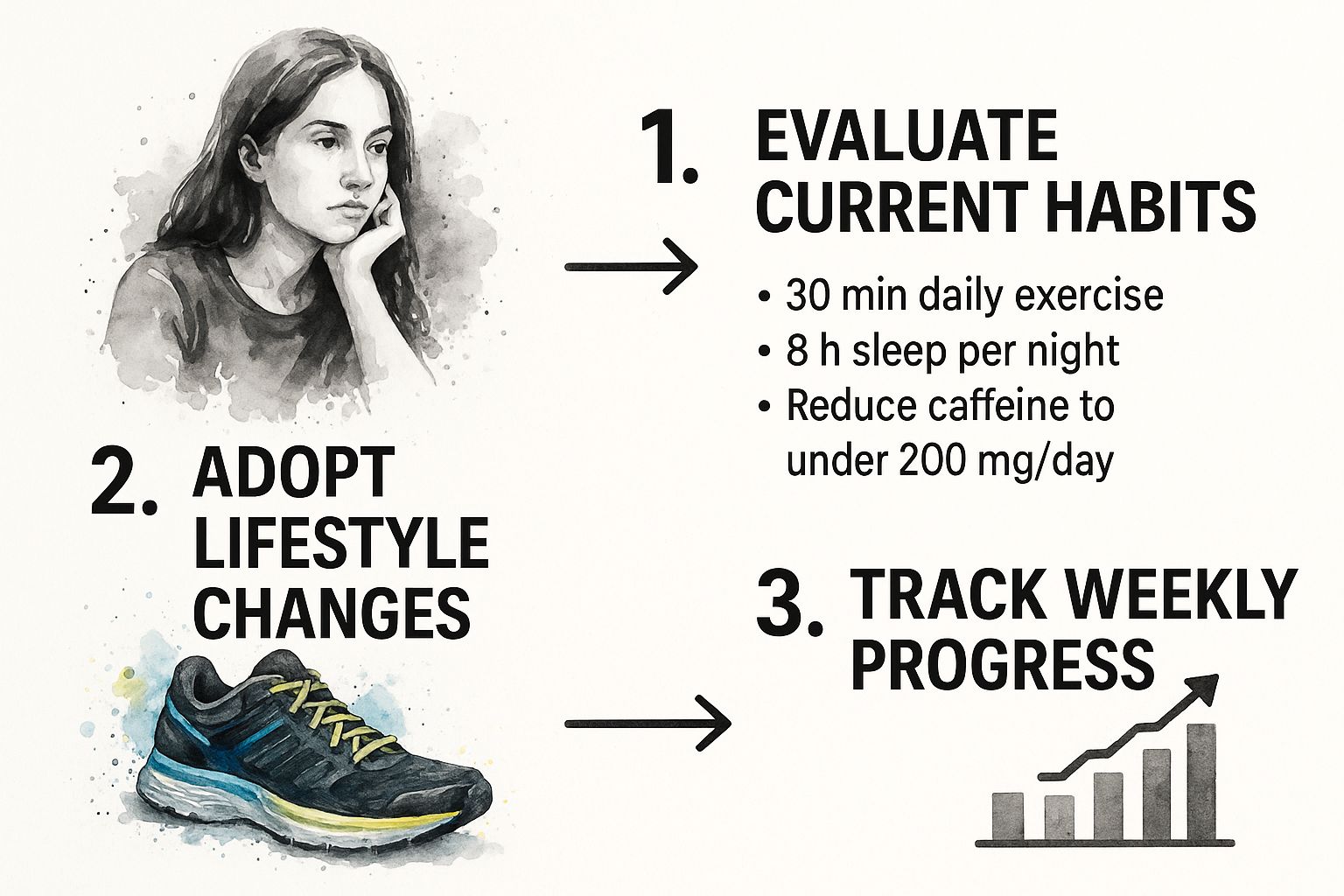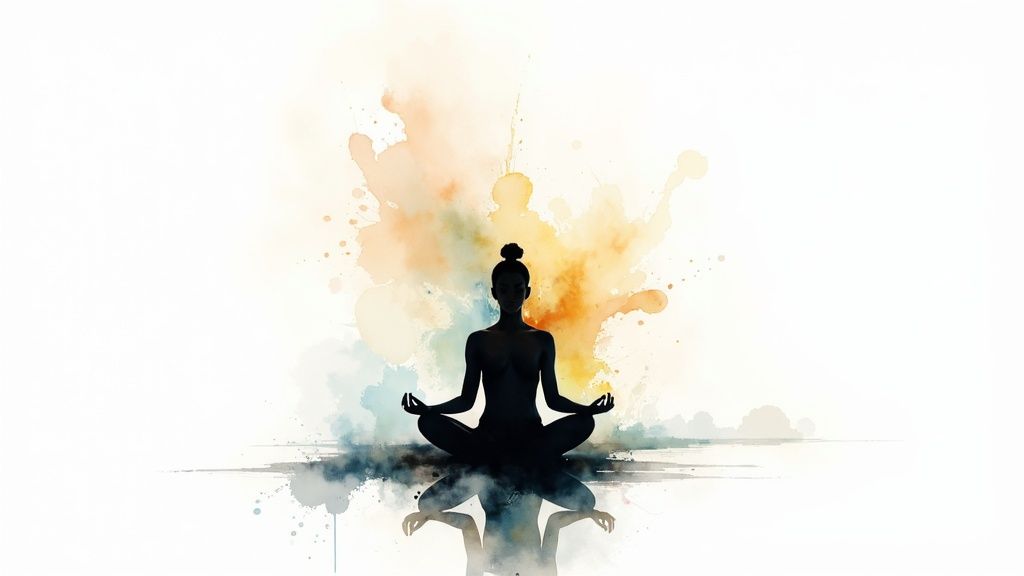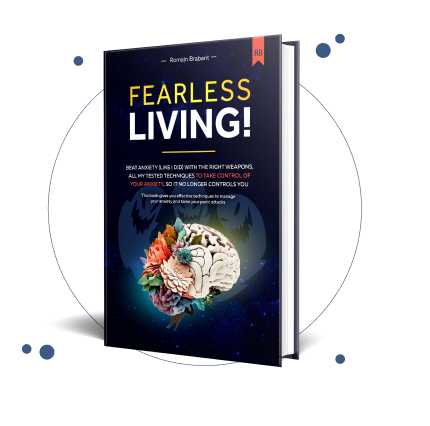
When a panic attack hits, it can feel like your world is collapsing. But I want you to hold onto this truth: you can find lasting relief and live a full, fearless life without medication. There are powerful, science-backed strategies that offer a reliable panic attack treatment without medication, putting you squarely in the driver's seat of your own healing journey.
Your Path to a Panic-Free Life Starts Here

Facing a panic attack is one of the most isolating experiences a person can endure. The racing heart, the fight for breath, the crushing sense that you’re in real danger—it's designed to convince you that you're utterly alone.
But that feeling is a trick your mind is playing on you. You are far from the only one going through this. More importantly, a future where fear doesn't run your life isn't just a hopeful idea; it's a completely achievable reality.
This guide is built on one simple, powerful belief: you have the capacity to heal. This isn't about waging a war against your anxiety, which often just fuels the fire. Instead, it’s about understanding what’s happening in your mind and body and learning new, compassionate ways to respond.
Embracing Non-Medication Strategies
For many, the idea of managing panic attacks without medication can feel daunting, but it’s a journey many have successfully taken, leading to profound and lasting freedom. Psychotherapy, especially hands-on approaches like Cognitive Behavioral Therapy (CBT), is widely considered one of the most effective treatments for anxiety symptoms.
These therapies are a top choice for a powerful reason. They address the root cause of the panic instead of just masking the symptoms, all without the risk of side effects or dependency. You can learn more about these powerful therapy options and discover what makes them so transformative.
What's truly empowering is that this approach equips you with skills for life. By learning to recognize and gently challenge the thought patterns that send you spiraling, you can fundamentally rewire your relationship with anxiety.
The goal isn't to eliminate anxiety entirely—it's a normal human emotion, after all. The goal is to stop it from escalating into panic. You learn to ride the wave of anxious feelings with confidence, knowing it won't pull you under.
Here’s a quick overview of the non-medication strategies we'll be exploring. These approaches form the foundation of a medication-free path toward a panic-free life.
Key Non-Medication Strategies for Panic Attacks
| Strategy | What It Is | How It Helps |
|---|---|---|
| Cognitive Restructuring | Identifying and gently challenging the negative, catastrophic thoughts that trigger panic. | Breaks the cycle of fear by changing your interpretation of physical sensations and anxious thoughts, restoring a sense of safety. |
| Exposure Therapy | Gradually and safely facing the situations or physical sensations that you fear, in a controlled way. | Retrains your brain to understand that feared situations are not dangerous, rebuilding your confidence to live freely. |
| Mindfulness & Grounding | Techniques to bring your focus to the present moment and your physical surroundings. | Pulls you out of the mental spiral of a panic attack and gently calms your nervous system. |
| Breathing Retraining | Specific breathing exercises designed to counteract the hyperventilation that worsens panic. | Regulates your heart rate and oxygen levels, sending powerful calming signals to your brain. |
| Lifestyle Adjustments | Changes to diet, exercise, sleep, and stress management routines. | Reduces your baseline level of anxiety, building resilience and making you less vulnerable to panic triggers. |
Each of these strategies gives you a tangible tool to use, building your confidence with every small success and proving that you are more powerful than your panic.
What You Can Expect to Learn
This guide is all about practical, actionable steps you can start using right away to reclaim your life. We’re going to move past theory and get into the real-world techniques that put you back in control. You will discover how to:
- Understand the Panic Cycle: See exactly how a harmless physical feeling can spiral into a full-blown attack and, more importantly, where to step in and break the chain.
- Rewire Anxious Thoughts: Use powerful cognitive tools to dismantle the "what if" thinking that fuels fear, replacing it with calm and clarity.
- Calm Your Nervous System: Master simple breathing and grounding exercises that can stop a panic attack in its tracks, giving you immediate relief.
- Build a Resilient Lifestyle: Make small, sustainable tweaks to your daily life that lower your overall anxiety and create a strong foundation for long-term peace.
This journey is about building confidence, one step at a time. Every technique you master is another tool in your toolkit, another piece of proof that you are capable and in control. A life free from the grip of panic is not just possible—it's waiting for you. Your path toward it starts right now.
How to Break the Panic Attack Cycle
To truly overcome panic attacks, especially if you're looking for ways to heal without medication, you first have to understand what you're up against. A panic attack isn't some random ambush. It's a predictable—and absolutely breakable—chain reaction in your mind and body. Seeing this loop clearly is the first step toward taking your power back.
It almost always starts with a trigger. This isn't usually something dramatic. More often than not, it’s a perfectly normal bodily sensation. Maybe you feel a bit dizzy after standing up too fast, or your heart flutters for a second after you climb a flight of stairs. It could even be a fleeting, anxious thought like, "What if I can't handle this?"
This is where the cycle really begins. Your brain, already on high alert from underlying anxiety, misreads this harmless signal as a genuine threat. This single moment of misinterpretation is what kicks off your body's ancient "fight or flight" response.
The Fight or Flight False Alarm
Once your brain hits the panic button and sounds the alarm, your autonomic nervous system (ANS) floods your body with adrenaline. This is a survival mechanism hardwired into us, designed to help you fight off a predator or flee a fire. The problem? There’s no real external threat.
This hormonal surge creates very real, very physical symptoms:
- A pounding or racing heart
- Shortness of breath or a feeling of being smothered
- Dizziness, lightheadedness, or feeling like you might faint
- Trembling or shaking
- Sweating or sudden chills
These feelings are intense and uncomfortable, but they are not dangerous. They are simply your body’s powerful, natural response to what it thinks is a life-or-death situation. The cycle gains momentum when you attach a catastrophic meaning to these feelings.
A key insight in overcoming panic is realizing that the fear is not of the initial trigger, but of the physical sensations themselves. You're not afraid of the crowded store; you're afraid of the feeling of your heart racing inside the crowded store.
The Feedback Loop of Fear
This is the point where the cycle locks in and escalates. You feel your heart racing, and your catastrophic thinking takes over: "This isn't normal. I must be having a heart attack." You feel dizzy and immediately think, "I'm going to faint or lose control right here."
These terrifying thoughts act as a new trigger, confirming your brain's initial assessment that you are, in fact, in grave danger. This signals your body to dump even more adrenaline into your system, which in turn intensifies the physical symptoms. A racing heart now feels like it's hammering against your chest. Mild dizziness turns into a terrifying sensation that the room is spinning.
The infographic below shows how introducing proactive lifestyle changes can weaken this cycle before it even gets a chance to start.

This process shows that consistent habits like exercise and good sleep can lower your baseline anxiety, making you far less likely to misinterpret benign physical sensations as threats in the first place.
Each stage feeds the next, creating a vicious feedback loop that can spiral into a full-blown panic attack in just a few minutes. The peak is terrifying, but it’s physiologically impossible for your body to sustain that level of arousal for long. The attack will always, always pass.
Recognizing this pattern is liberating. It transforms you from a passive victim of your body's alarms into an active, informed observer. You can learn to spot the stages as they unfold, creating just enough space to intervene. By gently challenging the catastrophic thoughts and becoming less afraid of the physical feelings through safe, gradual methods, you can systematically dismantle this cycle.
For those ready to take this a step further, learning about how exposure therapy for anxiety helps you safely face and neutralize these fears can be a game-changer. This is how you heal and break free.
Rewiring Your Thoughts with Cognitive Behavioral Techniques

Knowing the panic cycle is a huge first step, but this is where the real healing begins—learning to actively and compassionately take it apart. Instead of feeling like a passenger on a terrifying ride, you can learn to work with your mind, not against it.
This is the very essence of Cognitive Behavioral Therapy (CBT), which is widely considered the gold standard for panic attack treatment without medication.
The beauty of CBT is how practical and empowering it is. It’s built on a straightforward idea: your thoughts, feelings, and actions are all connected. When you change one, you start a positive domino effect that influences the others. For panic attacks, this means learning to notice those scary, catastrophic thoughts that fuel the fire of fear, and then gently guiding your mind to a calmer place.
CBT isn't just a popular idea; it's one of the most studied and effective non-medication treatments out there. Research shows that roughly 73% of patients become panic-free within three to four months of starting CBT. What's even more hopeful is that about 46% of those individuals are still panic-free two years later, which speaks volumes about the lasting power of these skills.
Catching Your Catastrophic Thoughts
Your first mission is to become a curious detective of your own mind. This means you need to get good at spotting the specific, automatic thoughts that flash through your head right before or during a panic wave. Therapists call these "catastrophic cognitions" because they leap straight to the worst-imaginable outcome.
Do any of these sound familiar?
- "My heart is pounding… I must be having a heart attack."
- "I feel lightheaded… I'm going to faint right here."
- "My mind is racing… I'm losing my grip."
- "I can't get enough air… I'm suffocating."
In the moment, these thoughts feel 100% real and incredibly urgent. But they are interpretations, not facts. The goal isn't to fight or block them. It's simply to notice them with kindness.
Start a simple log in a notebook or on your phone. Whenever you feel that familiar jolt of anxiety, jot down the physical feeling and the very first thought that came with it. This simple act of observation creates just enough space between you and the thought, helping you shift from pure reaction to a more conscious, empowered response.
Challenging and Reframing Your Thinking
Once you get better at catching those thoughts, the next step is to gently question them. This is a core CBT skill called cognitive restructuring. It’s like having a kind, supportive debate with your anxious mind, examining the evidence for and against your fearful thoughts. It's not about bullying yourself or saying "just stop worrying." It's about guiding your brain toward a more balanced, realistic perspective.
Let’s walk through a hopeful example.
The Catastrophic Thought: "My heart is racing so fast. I'm definitely having a heart attack."
Now, let's gently challenge it with a few questions:
- What’s the evidence for this thought? "My heart is beating hard, and my chest feels tight."
- What’s the evidence against it? "I've felt this exact sensation before, and it was a panic attack. My doctor said my heart is healthy. A heart attack usually comes with pain down the arm, and I don't have that."
- What’s a more realistic, balanced thought? "My heart is pounding because of an adrenaline rush. It’s a classic, though uncomfortable, symptom of panic. This feeling isn't dangerous, and it will pass, just like it always has. My body is just trying to protect me, and I am safe."
This isn't a one-time fix. It's a mental muscle you build with repetition. Every time you successfully challenge a catastrophic thought, you're weakening the old fear pathway in your brain and building a new, stronger one grounded in calm and self-trust.
If you want to go deeper on these techniques, check out our guide on understanding CBT for anxiety.
Facing the Fear of Physical Sensations
A critical part of CBT for panic involves getting comfortable with the very physical feelings you've come to fear. A powerful technique for this is called interoceptive exposure, where you learn to desensitize your brain in a safe, controlled way. It sounds intense, but it's about intentionally and gradually bringing on the sensations you're afraid of to prove their harmlessness.
The entire point of interoceptive exposure is to prove to your brain, through direct experience, that these physical sensations are not actually dangerous. You’re breaking the automatic link between a racing heart and the catastrophic thought that usually follows, reclaiming your power over them.
For example, if dizziness is a major trigger, you might spin in a chair for 30 seconds. If a pounding heart is your nemesis, you could do jumping jacks for a minute. You do these short exercises, allow the sensation to peak and then fade, and repeat the process until your fear begins to dissolve.
While it's best to do this with a therapist's guidance, it shows how you can systematically teach your body that it's safe.
By putting all these cognitive and behavioral tools together, you start building a robust system of inner resilience. You learn to spot the spark before it can become a wildfire, giving you not just hope, but the practical ability to live a life that isn't controlled by the fear of panic.
Practical Skills to Calm Your Body and Mind

When panic strikes, it’s like a biological alarm bell you can't shut off. Your mind might be racing, but your body is where the battle often feels most intense. The good news is that you can learn to manually turn down this alarm system. This is a core part of an effective panic attack treatment without medication.
These aren't just pleasant distractions; they are physiological tools. They work by directly intervening in the "fight or flight" response, calming your nervous system and reassuring your brain that the danger has passed. Learning these skills gives you a profound sense of agency when you feel most powerless, offering concrete actions you can take to regain your footing.
Master Your Breath to Master Your Nerves
During a panic attack, breathing often becomes shallow and rapid—a process called hyperventilation. This throws off the balance of oxygen and carbon dioxide in your body, which paradoxically leads to feelings of breathlessness, dizziness, and tingling. Those sensations then fuel even more panic.
Controlled breathing exercises can beautifully reverse this process. By deliberately slowing down your breath, you activate the vagus nerve, which runs from your brain to your gut. This sends a powerful signal to your parasympathetic nervous system—your body's "rest and digest" mode—to slow your heart rate and lower your blood pressure.
While we cover this in more detail in our guide on breathing exercises for anxiety, here’s a simple and powerful technique to start with:
The 4-7-8 Technique
- Exhale completely through your mouth, making a whoosh sound.
- Inhale quietly through your nose for a count of four.
- Hold your breath for a count of seven.
- Exhale forcefully through your mouth, making that whoosh sound again, for a count of eight.
Practicing this for just a few cycles can create a noticeable shift in your physical state, grounding you when you feel like you're spiraling and reminding you that you are in control.
Release Tension with Progressive Muscle Relaxation
Anxiety doesn't just live in your mind; it's stored in your body as muscle tension. You might clench your jaw, tighten your shoulders, or knot your stomach without even realizing it. Progressive Muscle Relaxation (PMR) is a fantastic grounding technique that teaches you to release this stored tension.
The process is simple: you systematically tense a specific muscle group for about five seconds, then consciously release it for 30 seconds, paying close attention to the wave of relaxation that follows.
For example, you could start with your hands and forearms. Make a tight fist, hold it, feel the strain, and then let it go completely. Notice the warmth and looseness that rushes in. You can work your way up your body, from your feet to your face, systematically releasing tension and letting go.
By practicing PMR, you not only release physical stress but also become more attuned to your body's signals. This makes it easier to notice and address rising tension before it can contribute to a full-blown panic attack, giving you an early sense of control.
Anchor Yourself in the Present with Your Senses
When panic hits, your mind is usually stuck in the future, worrying about what might happen. Mindfulness practices lovingly pull you back to the safety of the present moment. One of the most effective ways to do this is by focusing on your senses.
This can be as simple as the 5-4-3-2-1 grounding technique:
- Name five things you can see around you.
- Acknowledge four things you can touch or feel.
- Listen for three distinct sounds.
- Identify two different smells.
- Name one thing you can taste.
For some people, engaging the senses through other means provides immediate comfort. This can range from the physical sensations of PMR to exploring the benefits of relaxing scented candles to engage your sense of smell.
These skills are not just random tips; they form a crucial part of non-medication treatment frameworks like CBT. While panic attacks affect about 11% of adults globally each year, so many find lasting recovery by learning to manage their body’s responses. By building this toolkit, you are creating a hopeful, actionable path to a life free from panic.
In-the-Moment vs. Daily Practice Techniques
Some relaxation techniques are perfect for stopping a panic attack in its tracks, while others are best used daily to build long-term resilience. Understanding when to use each tool is key. The table below breaks down which methods are best for immediate relief versus ongoing prevention.
| Technique | Best for In-the-Moment Relief | Best for Daily Prevention |
|---|---|---|
| 4-7-8 Breathing | ✅ | ✅ |
| Progressive Muscle Relaxation (PMR) | ✅ | ✅ |
| 5-4-3-2-1 Grounding | ✅ | ❌ |
| Scented Candles/Aromatherapy | ✅ | ✅ |
| Regular Exercise | ❌ | ✅ |
| Mindful Meditation | ✅ | ✅ |
As you can see, many skills like controlled breathing and PMR pull double duty, helping both in a crisis and as part of a daily routine. Others, like the 5-4-3-2-1 technique, are designed specifically for grounding you in the present moment when you feel overwhelmed. Building a mix of both into your life gives you the most comprehensive and hopeful defense against panic.
Building a Panic-Resistant Lifestyle
True, lasting freedom from panic isn't just about getting through an attack. It's about fundamentally reshaping your life so that you are less vulnerable to panic in the first place. This is the heart of any effective panic attack treatment without medication.
It’s a shift from just surviving to actively building a life that supports your mental well-being. By making small, sustainable changes to your daily habits, you fortify your mind and body against the very triggers that kickstart the panic cycle. It’s about creating a strong foundation of calm. That way, when life’s inevitable stressors show up, you can meet them from a place of strength, not fear.
This approach hands the power back to you. There's a profound sense of hope in knowing your daily choices are directly contributing to your healing. You move from a reactive state of damage control to a proactive one of building genuine wellness. Let’s explore the three pillars of this lifestyle: movement, nutrition, and sleep.
Move Your Body to Calm Your Mind
The link between regular physical activity and a calmer mind is undeniable. Exercise is one of nature’s most potent gifts for mental health. When you move, your body releases endorphins—natural mood elevators that act like a gentle balm for an anxious nervous system.
At the same time, exercise helps burn off excess cortisol and adrenaline. Think of these as the stress hormones that fuel the fight-or-flight response. Movement gives all that anxious energy a healthy, productive outlet.
The goal isn’t to become a marathon runner overnight. The best kind of exercise is simply the one you'll stick with. Even 15-20 minutes of moderate activity each day can make a world of difference in building a more peaceful inner state.
Finding something you genuinely enjoy is the secret. It could be anything from a brisk walk in the park to dancing around your living room.
Ideas to Get You Moving:
- Walking or Hiking: Getting outside combines physical activity with the naturally soothing effects of nature.
- Yoga: This practice is exceptional for anxiety because it pairs physical postures with controlled breathing and mindfulness.
- Cycling: A fantastic low-impact way to get your heart rate up while exploring your neighborhood.
- Team Sports or Group Classes: The social connection can be an extra buffer against anxiety and isolation.
By making movement a non-negotiable part of your routine, you are actively lowering your baseline anxiety day by day. This makes your whole system more resilient and less reactive to panic triggers.
Fuel Your Nerves with Smart Nutrition
What you put on your plate has a direct, and often immediate, impact on your nervous system. An unsteady diet, especially one high in sugar and stimulants, can create a state of physiological stress that feels almost identical to the start of an anxiety attack.
A huge part of this is keeping your blood sugar stable. When you eat sugary foods or refined carbs, your blood sugar spikes and then crashes. That crash can bring on shakiness, dizziness, and heart palpitations—sensations that your brain can easily mistake for an oncoming panic attack.
Cutting back on stimulants is another game-changer. Caffeine is a major one, as it directly stimulates your adrenal glands and can trigger the same fight-or-flight response that happens during panic. For someone prone to panic attacks, even one cup of coffee can be enough to put their nervous system on high alert for the rest of the day.
To dive deeper into specific dietary adjustments, our complete guide on lifestyle and diet changes for anxiety management is packed with practical swaps and meal ideas to get you started on this supportive path.
Prioritize Restorative Sleep
Sleep is when your brain and body hit the reset button. Without it, your nervous system is left frayed and your ability to regulate emotions is seriously compromised. This dramatically lowers your threshold for stress and anxiety. You've probably felt it yourself—how just one bad night's sleep can leave you feeling irritable and on edge all the next day.
Improving your sleep hygiene—the habits and environment that set you up for good sleep—is one of the most powerful lifestyle changes you can make. It's all about creating a consistent, calming routine that signals to your body that it’s time to wind down.
Here are some actionable steps you can take tonight:
- Keep a Consistent Schedule: Try to go to bed and wake up around the same time every day, even on weekends.
- Create a Sanctuary: Make your bedroom as dark, quiet, and cool as possible.
- Have a Digital Detox: Put away screens (phones, tablets, TVs) for at least an hour before bed. The blue light can disrupt your body's production of melatonin, the sleep hormone.
- Wind Down with a Ritual: Read a book, take a warm bath, or listen to calming music to ease your mind and body into a state of rest.
These lifestyle adjustments aren't quick fixes; they are the pillars of long-term healing. Each healthy meal, every walk, and each restful night is an investment in a future where you are not just surviving, but thriving—calm, resilient, and finally free from the fear of panic.
Your Questions Answered
Starting a new path to recovery can bring up a lot of questions. It's totally normal to feel a mix of hope and a little bit of "what if?" as you begin this journey. The goal here is to give you clear, honest answers to the questions that come up most often when people decide to heal from panic attacks without medication.
Think of this as your space for clarity and reassurance. We'll get into realistic timelines, what to do when progress feels stalled, and whether you can truly heal this way. Let's build the confidence you need to move forward.
How Long Does This Really Take to Work?
This is usually the first question on everyone's mind. The honest answer? It's different for everyone. Your journey to a panic-free life is deeply personal, and how quickly you see results depends on many factors. That said, with consistent and compassionate effort, most people start to feel a real shift within a few weeks.
If you’re trying something more structured like Cognitive Behavioral Therapy (CBT), studies often show significant improvements within 8 to 15 weeks of regular sessions. The key word there is regular.
Healing isn’t a straight line. It's a journey of building new skills and gaining confidence. It's vital to celebrate the small wins—like using a breathing technique to calm a surge of panic or gently questioning an anxious thought. Those moments are the foundation of lasting change and proof that you are healing.
Think of it like tending a garden. You won't have a full harvest after planting the first seed. But if you water it and care for it every day, you'll start to see sprouts. Soon enough, you'll have a flourishing garden. Each small step forward is literally rewiring your brain to create healthier, more peaceful patterns.
What Do I Do When I Feel Stuck?
First, please know it's completely normal to have days where you feel like you're taking a step back. You’re making great progress, and then BAM—a wave of panic hits. A setback is not a failure. It’s an opportunity to practice your new skills with compassion for yourself.
But if you feel like you're consistently spinning your wheels and can't seem to get unstuck on your own, it might be time to bring in some loving support. A good therapist who specializes in anxiety can be a total game-changer. They can help you see the specific triggers and thought patterns that are keeping you trapped with a fresh, expert perspective.
A therapist can also guide you through more advanced techniques, like interoceptive exposure, in a way that feels safe and controlled. Think of them as an expert coach—they provide the strategy, encouragement, and accountability you need to finally break through. Reaching out for help is a sign of profound strength and a commitment to your own healing.
Can You Really Heal from Panic Without Medication?
Yes. Absolutely. A huge number of people have successfully overcome panic attacks and now live full, unrestricted lives without ever needing medication. The strategies we've talked about aren't just little coping tricks; they are powerful tools for deep, lasting change.
Research shows again and again that therapies like CBT have incredibly high success rates for creating a panic-free life. More importantly, they teach you skills you can use for the rest of your life. While medication can be a helpful tool for some, these non-medication techniques are designed to get to the root cause of the panic cycle.
By learning to change your relationship with your own thoughts and physical sensations, you're not just putting a temporary lid on the panic. You are fundamentally rewiring how your brain responds to fear, creating a new foundation of safety and self-trust. It takes work and commitment, but achieving real freedom this way is an incredibly realistic and hopeful goal.
You have the capacity to heal. All it requires is patience with yourself and a little faith in the process. With the right tools and consistent practice, you can and will build a life where fear no longer calls the shots.
Are you ready to stop managing your anxiety and start building a life free from its grip? The Anxiety Checklist provides a step-by-step system with practical, actionable tools to help you break free from the cycle of panic and fear. To start your journey toward fearless living, visit https://anxietychecklist.com.

